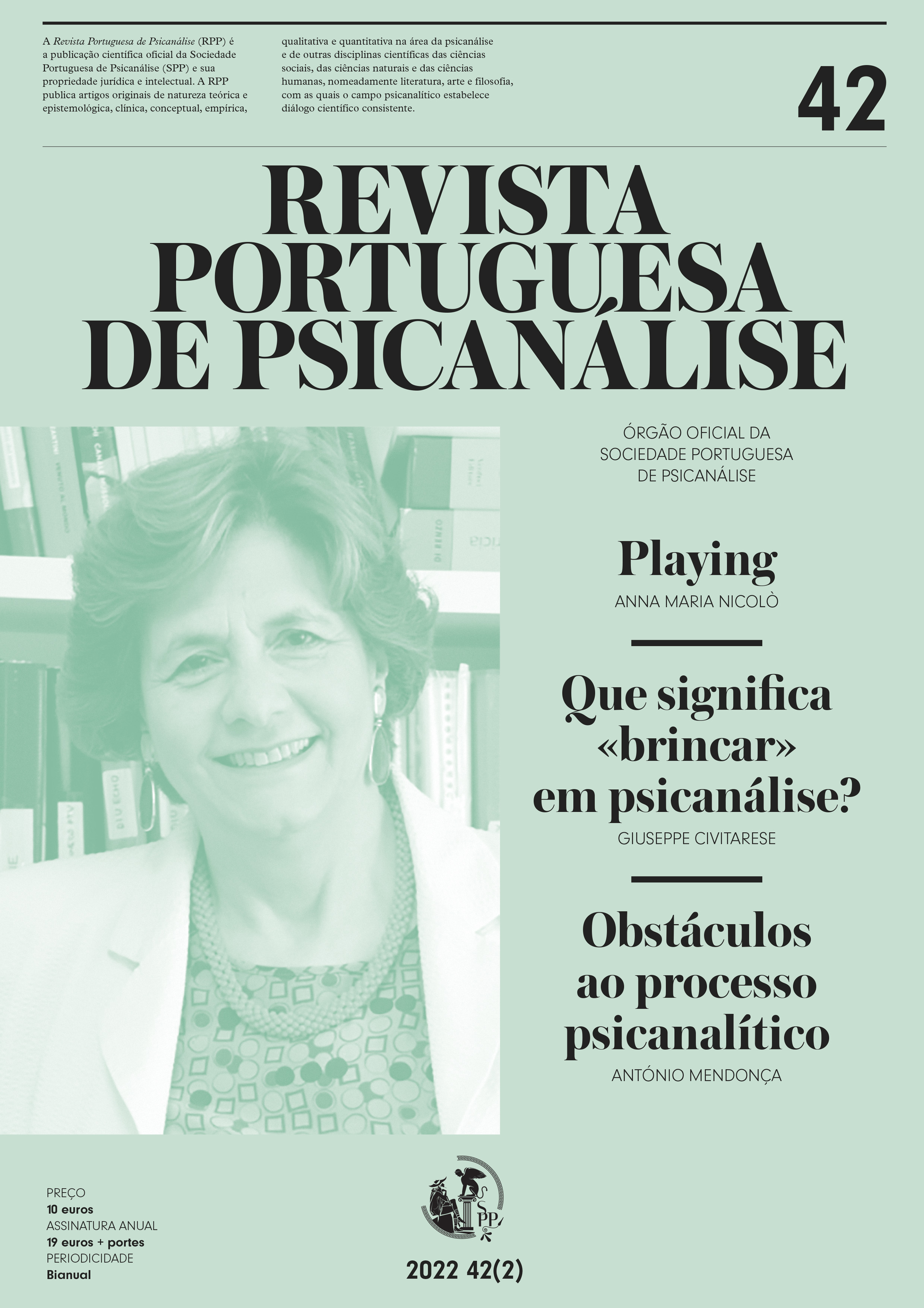Que significa «brincar» em psicanálise?

Résumé
«Brincar» em psicanálise tem que ver com a) escutar o discurso inconsciente como se virtualmente qualquer coisa possa refletir o sonho do par ou do campo analítico, b) interpretar o processo analítico não como uma correção às distorções da transferência, mas como uma promoção de transformações, c) adotar um estilo simples, direto e espontâneo de conversação com o paciente. No novo paradigma da psicanálise, que se pode definir como ontológico e já não epistémico, isto é, não tanto dirigido a revelar conteúdos recalcados, mas, sim, a promover novas funções psíquicas, a psicanálise da criança, onde o brincar tem uma posição relevante, oferece-se como modelo para a psicanálise dos adultos. Os conceitos de atividade, intensidade, curiosidade, prazer, exploração, espontaneidade, abertura, etc., tornam-se elementos que idealmente deveriam estar presentes em qualquer análise. No brincar, tudo é ficção, e brinca-se a dois. Brincar serve para fazer crescer a mente passando por momentos de sintonização emotiva (at-one-ment). Daqui a necessidade do analista de dispor de conceitos atualizados que lhe permitam intuir o que acontece no plano inconsciente no brincar At-one-ment Reconhecimento e partilhado da relação.
Biographie de l'auteur
Giuseppe Civitarese
Analista de formação e supervisão na Sociedade Psicanalítica Italiana (SPI), e membro da Associação Psicanalítica Americana (APsaA) e da Associação Psicanalítica Internacional (IPA).
Références
- Bion, W. R. (1959). Attacks on linking. The International Journal of Psychoanalysis, 40, 308–315.
- Bion, W. R. (1962). Learning from Experience. Tavistock Publications.
- Bion, W. R. (1965). Transformations: Change from Learning to Growth. Heinemann.
- Bion, W. R. (1967). Second Thoughts: Selected Papers of Psychoanalysis. Heinmann.
- Bion, W. R. (1991). A Memoir of the Future. Karnac Books. (Obra original publicada em 1975–1979.)
- Civitarese, G. (2016). Truth as Immediacy and Unison: A New Common Ground in Psychoanalysis? Commentary on Essays Addressing “Is Truth Relevant?”. Psychoanalytic Quarterly, 85, 449–501. DOI: 10.1002/psaq.12081
- Civitarese, G. (2018a). Sublime Subjects: Aesthetic Experience and Intersubjectivity in Psychoanalysis. Routledge.
- Civitarese, G. (2018b). Traduire l’expérience: le concept de transformation dans Bion et la théorie du champ analytique. Revue Française de Psychanalyse, LXXXII, 5, 1327–1386. DOI: https://doi.org/10.3917/rfp.825.1327
- Civitarese, G. (2019). On Bion’s Concepts of Negative Capacity and Faith. Psychoanalytic Quarterly, 88(4), 751–783. DOI: https://doi.org/1 0.1080/00332828.2019.1651176
- Civitarese, G. (2020a). Plea for a safe place.
- Journal of the American Psychoanalytic Association, 68(6), 1143–1154. DOI: https://doi. org/10.1177/0003065120980137
- Civitarese, G. (2020b). Regression in the Analytic Field. Romanian Journal of Psychoanalysis, 13,17–41. DOI: https://doi.org/10.2478/rjp- 2020-0015
- Civitarese, G. (2020c). I and You, by Donald Moss (Second Story Press, 2017) Review. International Journal of Psychoanalysis, 101, 217–221. DOI: https://doi.org/10.1080/00207578.2019.16554 30
- Civitarese G. (2021a). Cosa vuol dire “giocare” in analisi? Psicoterapia psicoanalitica: 1, 2021. DOI: 10.3280/PSP2021-001003
- Civitarese, G. (2021b). Intersubjectivity And Analytic Field Theory. Journal of the American Psychoanalytic Association, 69(5), 853–893. DOI: https://doi.org/10.1177/00030651211044788
- Civitarese G. (2021c). Experiences in Groups as a key to “late” Bion. The International journal of psycho-analysis, 102(6), 1071–1096. DOI: https:// doi.org/10.1080/00207578.2021.1927045
- Civitarese, G. (2021d). The limits of interpretation. A reading of Bion’s “On Arrogance”. International Journal of Psychoanalysis, 102: 236-257. DOI: https://doi.org/10.1080/0020757 8.2020.1827954
- Civitarese, G. (2021e). Invisible-Visual Hallucinations in Bion’s Attacks on linking. International Journal of Psychoanalysis, in press.
- Civitarese, G., & Berrini C. (2022a). On using Bion’s Concepts of Point, Line, and Linking in the Analysis of a 6-year-old Borderline Child. Psychoanalytic Dialogues, 32(1), 45–53.
- Civitarese, G. (2022b).What does it mean to ‘play’ in analysis? European Journal of Psychotherapy & Counselling, 24:1, 37-60. DOI: 10.1080/13642537.2022.2026445
- Eco, U. (1963). Diario minimo. Mondadori. Ferenczi, S. (2002). On the revision of the interpretation of dreams. Em M. Balint (Ed.), Final contributions to the problems and methods of psychoanalysis (pp. 238–243). Karnac Books. (Obra original publicada em 1931.)
- Ferro, A. (1999). The Bi-personal Field: Experiences in Child Analysis. Routledge (Obra original publicada em 1992.)
- Freud, S. (1908). Creative Writers and Day-Dreaming. Em The Standard Edition of the Complete PsychologicalWorks of Sigmund Freud (vol. 9, pp. 141–154). Hogarth Press.
- Freud, S. (1920). Beyond the pleasure principle. Em The Standard Edition of the Complete PsychologicalWorks of Sigmund Freud (vol. 18, pp. 1–64). Hogarth Press.
- Gadamer, H.-G. (2013). Truth and Method. Bloomsbury Academic. (Obra original publicada em 1975.)
- Genta, F. (2021). Le moment poétique en séance comme possible émergence du O Bionien. Conference at the Swiss Society of Psychoanalysis, 13 de março.
- Hegel, G. W. F. (2019). The Phenomenology of Spirit. Cambridge University Press. (Obra original publicada em 1807.)
- Heidegger, M. (2002 1950).The origin of the work of art. Em Off the Beaten Track (pp. 1–56). Cambridge University Press. (Obra original publicada em 1950.)
- Kristeva, J. (1984). Revolution in poetic language. Columbia University Press.
- Le Guen, C. (2013). Dizionario freudiano. Borla. (Obra original publicada em 2008.)
- Merleau-Ponty, M. (1995). Linguaggio, storia, natura. Corsi al Collège de France, 1952-1961, Bompiani. (Obra original publicada em 1968.)
- Ogden,T. H. (2007). On talking-as-dreaming. The International Journal of Psychoanalysis, 88, 575–589. DOI: https://doi.org/10.1516/PU23- 5627-04K0-7502
- Pasqualin, C. (2015). Il fondamento “patico” dell’ermeneutico. Affettività, pensiero e linguaggio nell’opera di Heidegger. Inschibboleth. Roma
- Pound, E. (1934). ABC of Reading. Faber & Faber. (Obra original publicada em 1934.)
- Waelder, R. (1933).The psychoanalytic theory of play. Psychoanal. Quarterly, 2:208–224.
- Weinshel, E. (1988). Play and Playing in Adults and in Adult Psychoanalysis: An Addendum to the Paper ‘On Inconsolability’. Bulletin of the Anna Freud Centre, 11, 108–127.
- Winnicott, D. W. (1971). Playing and Reality. Tavistock Publications.
- Winnicott, D.W. (1958).The capacity to be alone. The International Journal of Psychoanalysis, 39, 416–420.